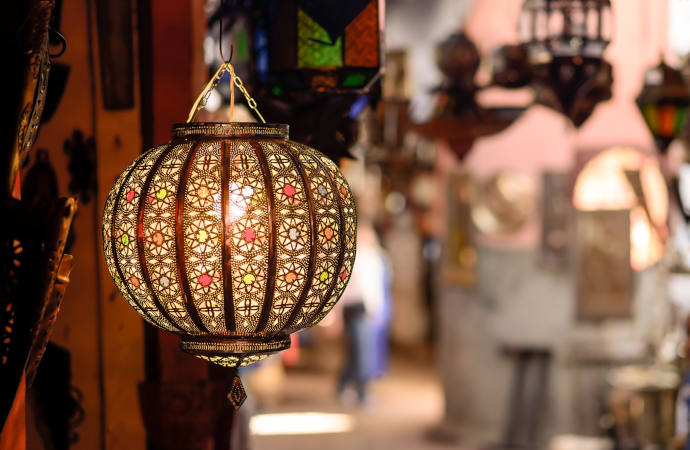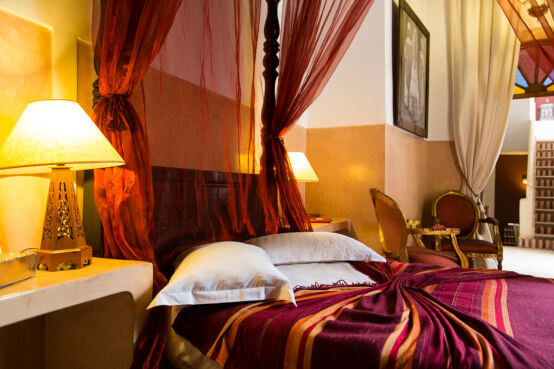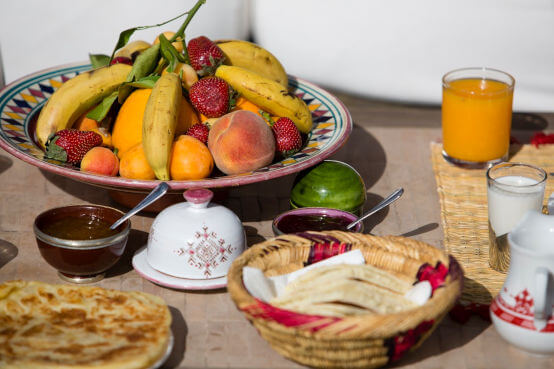
Marrakech is a shopper’s paradise. This bright and beautiful city offers the best of both worlds to shoppers from the mysterious buzzing souks to the modern wide boulevards and designer shops in Gueliz. Marrakech is a fascinating place to explore and really is one of the greatest shopping cities in the world, offering everything from textiles, furnishings and ceramics to decorative objects and clothing.
How to Get Around the Souks
To start, it’s important to grasp the fundamentals. The souk in Marrakech is an extensive and maze-like collection of vendors and stalls, extending from the bustling Jemaa el-Fna square all the way to the Musée de Marrakech. There are multiple entry and exit points within the souks, with the most prominent one being just behind the main square. The Marrakech souks are generally open from approximately 9am to 9pm daily, though these hours may vary during religious observances like Ramadan.
The Medina Souks
In the vibrant heart of the Medina, stretching north from Jemaa el-Fnaa square, are the souks of Marrakech. The Souks have over 3,000 stalls selling everything from brightly coloured glassware to leather goods, ethnic jewellery, rugs, brightly coloured kaftans, and all manner of trinkets.
This area can feel overwhelming, so it’s a good idea to acclimatise yourself in Jemaa el-Fnaa square before you spend hours exploring the souk’s chaotic web of shops and market stalls. Expect to get lost … several times.
Jemaa el-Fnaa
Jemaa el-Fnaa is the heart of Marrakech, a sprawling square that transforms from a daytime market to a nocturnal carnival. By day, the square is filled with orange juice stalls, snake charmers, and vendors selling traditional medicines. As night falls, it becomes a gastronomic spectacle with food stalls serving up steaming tagines and grilled meats. The square is not just a place to shop but an immersive cultural experience, where visitors can witness the living traditions of Marrakech in full display.
Souk Semmarine
Souk Semmarine is the largest and most famous souk in Marrakech, stretching from Jemaa el-Fnaa deep into the Medina. This covered market is a treasure trove of traditional Moroccan goods, including colourful babouche slippers, intricately woven carpets, shimmering lamps, and aromatic spices. The narrow alleys are lined with stalls and small shops, each specialising in different crafts.
Souk Chouari
Souk Chouari, also known as the Carpenter’s Souk, is a fascinating market specialising in woodwork and furniture. Here, skilled artisans can be seen crafting intricate cedar wood pieces, from ornate mirror frames to detailed furniture inlaid with mother of pearl. This souk offers a glimpse into the traditional woodworking techniques that have been passed down through generations in Morocco.
Gueliz
If you want a different shopping experience to haggling in the souks, head to Gueliz, the new part of Marrakech, which offers a completely different vibe to the traditional and chaotic Medina. Gueliz has European shops with familiar stores such as Mango and Zara and modern European-style buildings. You will find an interesting fusion of French and Moroccan architecture here.
The modern Gueliz region is renowned for its designer boutiques, specialty shops and galleries. One of the most famous galleries here is the Matisse Art Gallery, named after the famous French artist. The Marrakech Plaza at the centre is where you’ll find up-market shops, cafes and beautiful fountains. It’s a completely different feel to the souks in the Medina.
Sidi Ghanem
Sidi Ghanem is the urban industrial zone of Marrakech (located 5 km from the Medina). Here, you’ll find a plethora of artists, designers and craftspeople making and selling their wares from their workshops and showrooms. There are some great French eateries in the district too. Most shops here are closed on Saturday afternoons and Sundays.
What to Buy: Traditional Moroccan Goods

Marrakech’s markets are a treasure trove of traditional Moroccan goods that make for perfect souvenirs or additions to one’s home. Handwoven Berber carpets, with their intricate patterns and rich colours, are among the most sought-after items, along with leather goods, including bags, poufs, and babouche slippers, which showcase the city’s renowned leatherwork.
Vibrant ceramics, from decorative plates to tagine pots, reflect Morocco’s rich artistic heritage. Spices, particularly saffron from the nearby Atlas Mountains, are another must-buy for culinary enthusiasts. Each purchase not only serves as a memento of your visit but also supports the continuation of traditional craftsmanship.
Advice for Shopping in Marrakech’s Souks
Choose Your Timing Wisely
The time of day you visit the souks in Marrakech can greatly affect your shopping experience. For a more relaxed and less crowded atmosphere, aim to arrive early, around 9:30am, when the stalls are just opening. However, if you’re on the hunt for a bargain, consider visiting the souks in the evening, just before they close around 9 p.m. During this time, sellers might be more willing to offer discounts as they try to make last-minute sales.
Plan Your Approach
A useful strategy when shopping in the souks is to focus on the stalls a little ahead of the one you’re currently passing. In Marrakech, making eye contact with a vendor often signals the start of a sales pitch. So, if you’re just browsing and not ready to negotiate or buy, it’s best to avoid direct eye contact with the vendors as you walk by.
Brush Up on Your Arabic
Appearing less like a tourist can sometimes help you get better prices. Learning a few Arabic phrases can make you seem like a more experienced traveller who knows the ropes. For instance, saying “la, shukran” instead of “no, thank you” can be more effective in politely declining offers from persistent sellers or guides. Additionally, locals will appreciate your effort to learn their language and engage with their culture.
Dress Modestly
While everyone should have the freedom to dress as they please, blending in with the locals by dressing modestly can help you avoid standing out as a tourist. Respecting the predominantly Muslim culture of the area, where modesty is valued, will show you’re being respectful and knowledgeable about local customs.
Ask Before Taking Photos
A key aspect of cultural respect in Morocco, particularly in the souks, is to always ask permission before taking photos of people. Some vendors don’t mind being photographed if you ask first, but many prefer not to be.
Happy shopping in Marrakech. If you have something particular you are looking for, or would like to know more about what to see and do in Marrakech please ask us. We know Marrakech like the back of our hands.





